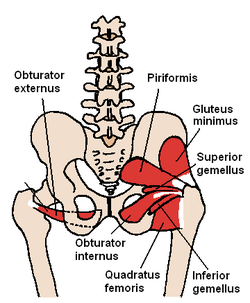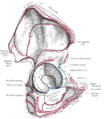Superior gemellus muscle
| Superior gemellus muscle | |
|---|---|
 The superior gemellus and nearby muscles | |
 Muscles of the gluteal and posterior femoral regions. Gemellus superior muscle labeled | |
| Details | |
| Origin | spine of the ischium |
| Insertion | Obturator Internus tendon |
| Artery | Inferior gluteal artery |
| Nerve | nerve to obturator internus (L5, S1, S2) |
| Actions | Rotates laterally thigh |
| Identifiers | |
| Latin | Musculus gemellus superior |
| TA98 | A04.7.02.013 |
| TA2 | 2606 |
| FMA | 22318 |
| Anatomical terms of muscle | |
The superior gemellus muscle is a muscle of the human body.
The Gemelli are two small muscular fasciculi, accessories to the tendon of the Obturator internus which is received into a groove between them.
The Gemellus superior, the smaller of the two, arises from the outer (gluteal) surface of the spine of the ischium, blends with the upper part of the tendon of the Obturator internus. In some people, the fibres of the gemellus superior extend further than average, and are prolonged onto the medial surface of the greater trochanter of the femur.[1]
The gemellus superior and gemellus inferior help to laterally rotate the extended thigh.[2] Both muscles also help to steady the femoral head in the acetabulum by assisting the obturator internus muscle, "The gemelli aid obturator internus in its action. As obturator internus turns around the lesser sciatic notch it loses some of its power; this is compensated for by the action of the gemelli."[3]
Etymology: Gemellus is the diminutive of "geminus" meaning twin, doubled or duplicated. The superior and inferior Gemellus muscles are paired and perform the same action.
See also
Additional images
-
Superior gemellus muscle.
-
Right hip bone. External surface.
-
Right femur. Anterior surface.
References
- ^ Palastanga, NIgel; Soames, Roger (November 2011). Physiotherapy Essentials : Anatomy and Human Movement : Structure and Function (6th ed.). London, GBR: Elsevier Health Sciences. p. 237. ISBN 9780702035531.
{{cite book}}:|access-date=requires|url=(help) - ^ Palastanga, NIgel; Soames, Roger (November 2011). Physiotherapy Essentials : Anatomy and Human Movement : Structure and Function (6th ed.). London, GBR: Elsevier Health Sciences. p. 235. ISBN 9780702035531.
{{cite book}}:|access-date=requires|url=(help) - ^ Palastanga and Soames, p. 237.
![]() This article incorporates text in the public domain from page 477 of the 20th edition of Gray's Anatomy (1918)
This article incorporates text in the public domain from page 477 of the 20th edition of Gray's Anatomy (1918)
- Palastanga, Nigel and Soames, Roger (2011). "Physiotherapy Essentials : Anatomy and Human Movement : Structure and Function (6th Edition)". Elsevier Health Sciences.
External links
- . GPnotebook https://www.gpnotebook.co.uk/simplepage.cfm?ID=-234487729.
{{cite web}}: Missing or empty|title=(help) - Anatomy photo:13:st-0402 at the SUNY Downstate Medical Center
- PTCentral
- Univ. of Wash. Radiology


